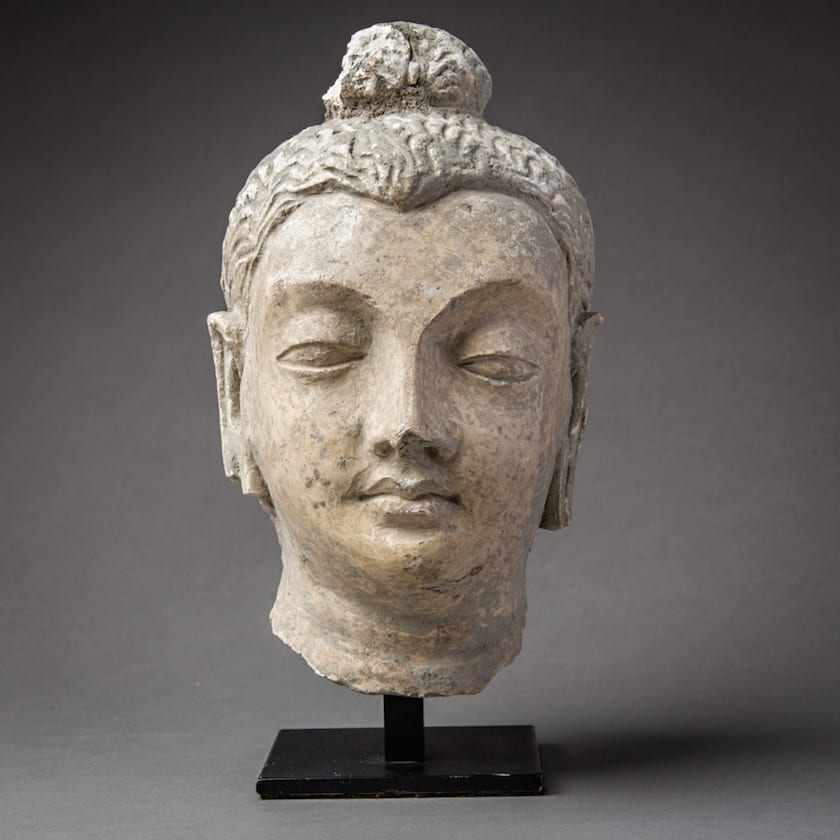Gandharan Stucco Buddha Head, 100 CE - 400 CE
Stucco
height 20.3 cm
height 8 in
height 8 in
AM.0219
Further images
The ancient civilization of Gandhara was located in the region encompassing modern northeastern Afghanistan and northwestern Pakistan. Situated at a confluence of trading paths along the Silk Route, the area...
The ancient civilization of Gandhara was located in the region encompassing modern northeastern Afghanistan and northwestern Pakistan. Situated at a confluence of trading paths along the Silk Route, the area was flooded in diverse cultural influences ranging from Greece to China. Gandhara flourished under the Kushan Dynasty and their great king, Kanishka, who is traditionally given credit for spreading the philosophies of Buddhism throughout central Asia and into China. This period is viewed as the most important era in the history of Buddhism. After the conquests of Alexander the Great, the creation of Greco-Bactrian kingdoms, and the general Hellenization of the subcontinent, Western aesthetics became prominent. Greek influence began permeating into Gandhara. Soon sculptors based the images of the Buddha on Greco-Roman models, depicting Him as a stocky and youthful Apollo, complete with stretched earlobes and loose monastic robes similar to a Roman toga. The extraordinary artistic creations of Gandhara reveal links between the different worlds of the East and West.
This dignified Buddha head was created from stucco. This material is easily manipulated and can produce wonderfully smooth surfaces, as is apparent on the face, especially the eyelids. The curled hair has been arranged in a top-knot, the Gandharan version of the ushnisha, or mound which symbolises the Buddha’s wisdom. Despite slight damage to the earlobes and the nose this head is well-preserved. The large almond shaped eyes and the downward gaze indicate a state of meditation, far removed from the cares of an earthly existence. According to tradition Buddhism was first introduced into the Gandharan region under the patronage of Asoka, emperor of the Mauryan dynasty, in the third century B.C. The first significant physical remains to survive, including stupas and figurative sculpture, date from the first century B.C. In subsequent centuries Gandharan monks were to play an important role in the spread of Buddhism into other parts of Asia, especially China. Images such as this head must have aided this process since they would have been encountered by the many traders, soldiers and travellers passing through the region.
This dignified Buddha head was created from stucco. This material is easily manipulated and can produce wonderfully smooth surfaces, as is apparent on the face, especially the eyelids. The curled hair has been arranged in a top-knot, the Gandharan version of the ushnisha, or mound which symbolises the Buddha’s wisdom. Despite slight damage to the earlobes and the nose this head is well-preserved. The large almond shaped eyes and the downward gaze indicate a state of meditation, far removed from the cares of an earthly existence. According to tradition Buddhism was first introduced into the Gandharan region under the patronage of Asoka, emperor of the Mauryan dynasty, in the third century B.C. The first significant physical remains to survive, including stupas and figurative sculpture, date from the first century B.C. In subsequent centuries Gandharan monks were to play an important role in the spread of Buddhism into other parts of Asia, especially China. Images such as this head must have aided this process since they would have been encountered by the many traders, soldiers and travellers passing through the region.







